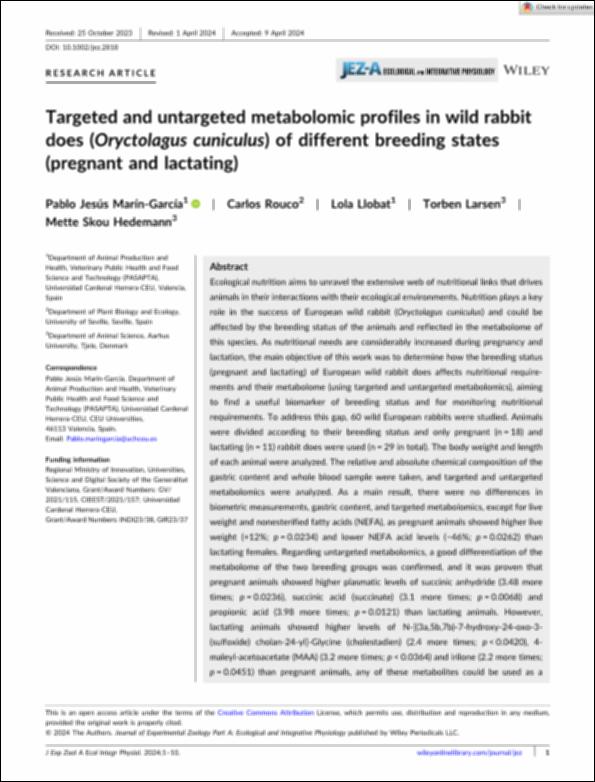Por favor, use este identificador para citar o enlazar este ítem:
http://hdl.handle.net/10637/15884Targeted and untargeted metabolomic profiles in wild rabbit does ("Oryctolagus cuniculus") of different breeding states (pregnant and lactating)
| Título : | Targeted and untargeted metabolomic profiles in wild rabbit does ("Oryctolagus cuniculus") of different breeding states (pregnant and lactating) |
| Autor : | Marín García, Pablo Jesús Rouco, Carlos Llobat Bordes, Lola Larsen, Torben Hedemann, Mette Skou |
| Materias: | Nutrición animal; Animal nutrition; Genética animal; Animal genetics; Embarazo; Pregnancy; Ácidos grasos; Fatty acids; Ácido succínico; Succinic acid; Veterinaria; Veterinary medicine |
| Editorial : | John Wiley & Sons |
| Citación : | Marín-García, P.J., Rouco, C., Llobat, L., Larsen, T. & Hedemann, M.S. (2024). Targeted and untargeted metabolomic profiles in wild rabbit does (Oryctolagus cuniculus) of different breeding states (pregnant and lactating). Journal of Experimental Zoology. Part A, Ecological and Integrative Physiology, Online Version of Record. DOI: https://doi.org/10.1002/jez.2818 |
| Resumen : | Ecological nutrition aims to unravel the extensive web of nutritional links that drives animals in their interactions with their ecological environments. Nutrition plays a key role in the success of European wild rabbit (Oryctolagus cuniculus) and could be affected by the breeding status of the animals and reflected in the metabolome of this species. As nutritional needs are considerably increased during pregnancy and lactation, the main objective of this work was to determine how the breeding status (pregnant and lactating) of European wild rabbit does affects nutritional requirements and their metabolome (using targeted and untargeted metabolomics), aiming to find a useful biomarker of breeding status and for monitoring nutritional requirements. To address this gap, 60 wild European rabbits were studied. Animals were divided according to their breeding status and only pregnant (n = 18) and lactating (n = 11) rabbit does were used (n = 29 in total). The body weight and length of each animal were analyzed. The relative and absolute chemical composition of the gastric content and whole blood sample were taken, and targeted and untargeted metabolomics were analyzed. As a main result, there were no differences in biometric measurements, gastric content, and targeted metabolomics, except for live weight and nonesterified fatty acids (NEFA), as pregnant animals showed higher live weight (+12%; p = 0.0234) and lower NEFA acid levels (−46%; p = 0.0262) than lactating females. Regarding untargeted metabolomics, a good differentiation of the metabolome of the two breeding groups was confirmed, and it was proven that pregnant animals showed higher plasmatic levels of succinic anhydride (3.48 more times; p = 0.0236), succinic acid (succinate) (3.1 more times; p = 0.0068) and propionic acid (3.98 more times; p = 0.0121) than lactating animals. However, lactating animals showed higher levels of N-[(3a,5b,7b)-7-hydroxy-24-oxo-3-(sulfoxide) cholan-24-yl]-Glycine (cholestadien) (2.4 more times; p < 0.0420), 4-maleyl-acetoacetate (MAA) (3.2 more times; p < 0.0364) and irilone (2.2 more times; p = 0.0451) than pregnant animals, any of these metabolites could be used as a potential biomarker. From these results, it can be concluded that the most notable changes were observed in the metabolome of individuals, with most of the changes observed being due to energy and protein mobilisation. |
| URI : | http://hdl.handle.net/10637/15884 |
| Derechos: | http://creativecommons.org/licenses/by/4.0/deed.es Open Access |
| ISSN : | 1932-5223 2471-5646 (Electrónico) |
| Cubierto por: | Acuerdo Transformativo – 2024 |
| Fecha de publicación : | 2024 |
| Centro : | Universidad Cardenal Herrera-CEU |
| Aparece en las colecciones: | Dpto. Producción y Sanidad Animal, Salud Pública Veterinaria y Ciencia y Tecnología de los Alimentos |
Los ítems de DSpace están protegidos por copyright, con todos los derechos reservados, a menos que se indique lo contrario.


